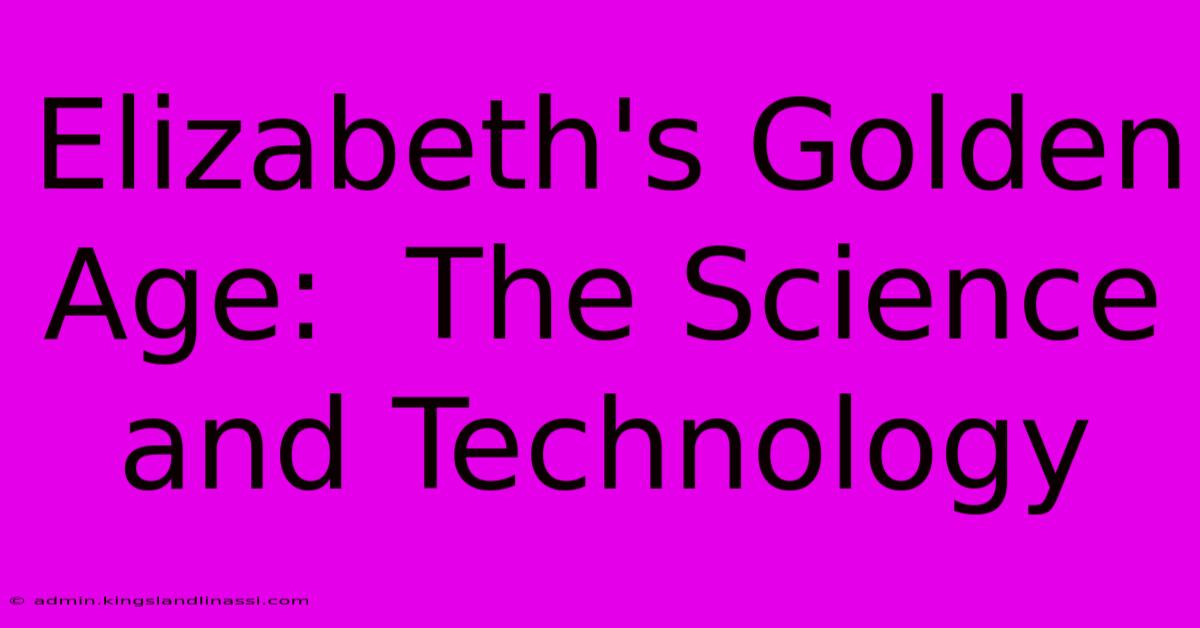Elizabeth's Golden Age: The Science And Technology

Table of Contents
Elizabeth's Golden Age: A Flourishing of Science and Technology
The reign of Queen Elizabeth I (1558-1603) is often romanticized as a "Golden Age," a period of unprecedented cultural and economic prosperity for England. While Shakespeare and exploration dominate the narrative, Elizabethan England also witnessed significant advancements in science and technology, laying the groundwork for future breakthroughs. This article delves into the key scientific and technological developments of this fascinating era.
Navigation and Exploration: Charting New Territories
Elizabethan England's ambition for global dominance fueled substantial progress in navigation and shipbuilding. The quest for new trade routes and resources spurred innovation. Improved cartography became crucial, with mapmakers like Gerardus Mercator refining projection techniques that made long-distance navigation significantly easier. The development of better navigational instruments, including the improved astrolabe and quadrant, allowed sailors to more accurately determine their latitude and longitude, reducing the risks of getting lost at sea. Shipbuilding technology also advanced, with the construction of larger, more seaworthy vessels capable of undertaking longer voyages. These advancements directly supported the voyages of exploration undertaken by figures like Sir Francis Drake and Sir Walter Raleigh, expanding England's global reach and influence.
Key advancements in Navigation and Exploration:
- Mercator Projection: Revolutionized mapmaking, making navigation easier.
- Improved Astrolabe and Quadrant: Enhanced accuracy in determining location.
- Larger, more seaworthy ships: Enabled longer and safer voyages.
Scientific Advancements and the Rise of Scientific Method
While not as revolutionary as later periods, the Elizabethan era saw the seeds of the scientific revolution being sown. The emphasis on observation and empirical evidence, though still nascent, started to challenge traditional scholastic thought. William Gilbert, Queen Elizabeth's physician, made significant contributions to the understanding of magnetism and electricity, publishing his influential work De Magnete in 1600. His meticulous experimental approach laid the foundation for future scientific inquiry. The growing interest in natural philosophy led to the establishment of new institutions and the fostering of intellectual exchange, paving the way for the more dramatic scientific breakthroughs of the 17th century.
Prominent Figures and their Contributions:
- William Gilbert: Pioneering work on magnetism and electricity.
- Early Natural Philosophers: Laid the groundwork for the scientific revolution.
Technological Innovations Beyond the Seas:
The Elizabethan era also witnessed technological progress beyond navigation. Printing technology continued to advance, making books and information more accessible. This contributed to the spread of knowledge and ideas, fostering intellectual growth. Metallurgy also saw improvements, with advancements in iron and brass production contributing to the development of better tools and weaponry. The construction of more sophisticated watermills and windmills improved agricultural efficiency and provided power for various industrial processes.
Technological advancements on land:
- Improved Printing: Wider dissemination of knowledge.
- Advanced Metallurgy: Better tools and weaponry.
- Efficient Water and Windmills: Enhanced agricultural and industrial output.
Legacy of Elizabeth's Golden Age:
The scientific and technological advancements of Elizabeth's reign, while perhaps less dramatic than those of later centuries, were crucial in setting the stage for the scientific revolution. The emphasis on exploration, the improvements in navigation and shipbuilding, and the nascent development of the scientific method all contributed to England's rise as a global power and laid the foundation for future scientific and technological progress. The legacy of Elizabeth's "Golden Age" extends far beyond the realms of literature and the arts; it includes a significant contribution to the world of science and technology. Further research into this period reveals a rich tapestry of innovation and discovery, highlighting the complex interplay between exploration, technological advancement, and the rise of a new scientific spirit.

Thank you for visiting our website wich cover about Elizabeth's Golden Age: The Science And Technology. We hope the information provided has been useful to you. Feel free to contact us if you have any questions or need further assistance. See you next time and dont miss to bookmark.
Featured Posts
-
Son By Fours A Puro Dolor The Impact It Made
Apr 28, 2025
-
Escape From The Past Don Juans Reckless Daughter
Apr 28, 2025
-
A Fathers Goodbye I Only Came To Find My Dad
Apr 28, 2025
-
Michael Polansky His Net Worth And Business Strategies
Apr 28, 2025
-
Stay Connected Check Honduras Time
Apr 28, 2025
